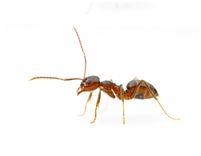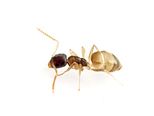ANTS
Have ant problems? Ants can easily find their way inside your home and help themselves to any available food source. Learn about different species of ants you may find in your home and the way they operate as a colony, as well as your options to fight them. Discover how to control ants with the help of the TERRO® family of products. We offer effective ant prevention and control solutions for the inside and outside of your home!
Common Ant Species
Argentine Ants
Argentine ants are readily adaptable and can nest in a great variety of places. They often live in soil, under wood, logs, debris or mulch. They may also nest in cavities at the base of shrubs and trees.
Colonies are massive and may contain hundreds of queens. Argentine ants do not establish new nests through swarming. New nests are, instead, constructed around the original, and remain connected to the queen’s old colony. Over time, the network of interconnecting colonies could become a massive infestation. Each colony of Argentine ants can contain millions of insects and multiple queens. These colonies can populate entire city blocks.
These ants travel in trails between their web of nests and food sources. Argentine ants feed on sweets, honeydew and oily household foods.
Carpenter Ants
Carpenter ants are among the largest ants in the United States, ranging from 3.4 to 13 mm long. While many people think carpenter ants eat wood, they do not. Instead, they nest in moist, decaying or hollow wood. They cut paths into the wood grain to form their nests and remove wood and deposit the debris outside of their nests in small piles. This activity produces wood shavings which is a clue to their presence in and around your home.
Carpenter ants will feed on a variety of food people eat—particularly sweets and meats. They will also feed on other insects.
If treated early, carpenter ants are seldom responsible for serious structural damage to houses and buildings. However, these ants could cause extreme damage if they continue undiscovered for an extended period.
Crazy Ants
Crazy ants get their name from the fact that they often look frantic and erratic in their movement, like they are lost, instead of following a defined trail. Crazy ants' legs are extremely long and give it a very distinct appearance.
Since they were discovered in 2002, crazy ants have quickly spread to Texas, Florida, Mississippi and Louisiana. They form networks of colonies with multiple queens, "super colonies", and have quickly upped their numbers from a few thousand to hundreds of millions.
Crazy ants are highly versatile, living in both moist and dry habitats. They cannot survive extremely cold climates and may infest houses and buildings when weather changes. It’s estimated that they cause about $146.5 million in electrical damage a year when millions of ants are electrocuted in small circuits or wires, where they seek warmth. Crazy ant workers are omnivorous, feeding on both dead and live insects, honeydew produced from insects, fruits, plant secretions, seeds and a variety of household food items such as sweets, meats, grease and liquids.
Fire Ants
Fire ants are probably one of the more feared ant species out there, and rightfully so. They are very aggressive ants and will latch onto victims and inject their stingers, delivering a nice dose of venom. The venom of fire ants causes painful burning. Not to mention, fire ants have been known to destroy plants, crops, leaves, seeds and fruit.
Most commonly found in the southern United States, fire ants can also be found as far north as Virginia. Like some other pests we contend with, fire ants were originally brought to the United States through a port in Alabama.
Fire ants live in mounds which are both above and well below the surface of the ground. Fire ants can build impressive colonies, with as many as 500,000 worker ants.
Ghost Ants
The ghost ant gets its name from its size and pale color of its legs and abdomen, which make it difficult to see. These ants have dark heads and thoraxes.
Ghost ants are tropical ants that have been in south and central Florida for several years. In northern states, these ants have been known to survive only in heated buildings and greenhouses.
These ants eat honeydew that they collect from plant-feeding insects. The worker ants also gather insects to feed the colony. When they are indoors, ghost ants usually prefer sweets.
They enter buildings on trails that they make along the ground. They also enter houses by trailing on utility lines or by following limbs of trees and shrubs that touch the house. When ghost ants make nests indoors, it is usually in flowerpots, behind baseboards and inside wall voids. The colony may split into several nests. It is normal to find ghost ants trailing between multiple nesting sites.
Little Black Ants
Little black ants are a native species found throughout the United States. They are small (as their name implies) and dark brown, black or jet black in color.
They have moderate- to large-sized colonies, with two or more queens in one colony. Little black ant swarms are common from June to August, mated females form new colonies, which grow quickly.
Outside, they build nests in areas such as woodwork voids, rotting logs, cracks in cement, lawns and open areas. Indoors, the little black ant can be located in wooden items as well as in walls and the junction between the carpet and walls. When infestation occurs, gaps and cracks in exterior walls should be sealed. It is important to remove decaying wood, firewood and other debris surrounding a home if an infestation is suspected. While it is difficult to see little black ants due to their small size, their nests can be located by following the trail of a worker ant back to its colony.
Odorous House Ants
Odorous house ants have small, dark brown or black bodies with an unevenly shaped thorax. However, the most distinguishable characteristic of odorous house ants is the smell of rotten coconut that is given off when their bodies are crushed.
Inside buildings, they are often found nesting in the walls or beneath the floor. They are most likely to invade buildings during rainy weather. Odorous ants travel in trails, foraging day and night.
Outdoors, odorous ants often feed on honeydew, a sugary waste produced from sap from feeding insects such as aphids. Inside buildings, they prefer sweet items but will also feed on meats and grease.
Because odorous house ants tend to forage inside homes, they can easily contaminate human food supplies. While odorous house ants do not sting or bite, they can become persistent pests, traveling indoors in large numbers.
Pavement Ants
Pavement ants are found throughout the United States and are major pests in the Midwest. They earned their name because they nest in cracks in driveways and under sidewalks, piling the resulting dirt in a mound on top of the pavement.
Pavement ants invade buildings while foraging for food. A pavement ant feeds on a wide variety of foods, including meats, grease, live and dead insects, seeds and honeydew from aphids. Pavement ants prefer to eat greasy foods, and can eat many foods consumed by humans. They forage for food for their colonies and set up trails to food sources from their nests.
Nests are outdoors under stones, along curbs or in cracks of pavement. They can nest indoors in walls and under floors. Pavement ant workers enter houses to forage and can become a nuisance when large groups infest a kitchen or garden patio. They can sting and bite.









